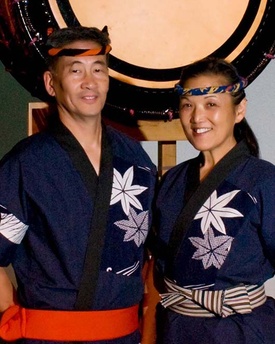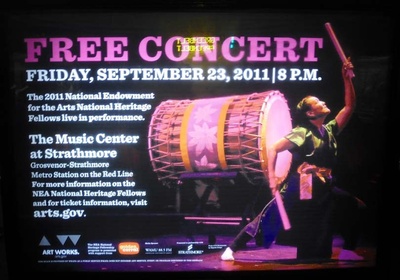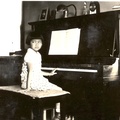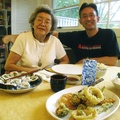This September 2011, PJ and Roy Hirabayshi, who led San Jose Taiko for over 35 years, were formally recognized in Washington D.C. as National Heritage Fellows, an award presented annually by the National Endowment for the Arts and the most prestigious honor for artists working in folk and traditional arts. This is the second time that taiko artists have received this distinction, and it reflects how the form, in its diverse styles and philosophies, has become an intrinsic part of the cultural landscape of the United States.
Taiko and the Heritage Awards
Ten years ago this month, just a week after the September 11 terrorist attacks, the NEA presented a concert of its 2001 National Heritage Fellows. Seiichi Tanaka, founder of the first American taiko ensemble, San Francisco Taiko Dojo, was among them, and he opened the concert with a cleansing ceremony. Audience members, still reeling from the attacks, described how after this prelude and when all the Fellows were introduced, “….it suddenly felt as if one could feel good about feeling good again.”
This remark reflects the compelling nature of the National Heritage Fellowship program and the artists it honors. It also speaks to the power of traditional arts—based as they are in community life—to comfort, restore, and inspire.
In the late 1970s, Bess Lomax Hawes, the first director of the NEA’s Folk & Traditional Arts program, was charged with developing awards modeled on Japan’s “living national treasures” certification. The first National Heritage Fellowships were granted in 1982.
In this program, master artists are identified through nominations submitted by individuals in their communities. These nominations, which include work samples and letters of support, are reviewed annually by a panel of specialists, which always includes one “lay person.” Every year from a field of over 250 nominations, the panel selects nine to twelve honorees, which reflect what NEA Folk & Traditional Arts program director Barry Bergey refers to as their “particular vision of e pluribus unum.” By this he refers to the changing, yet always impressive, range of regions, cultures, and art forms that comprise each slate of awardees. This year, for example, PJ and Roy Hirabayashi share the spotlight with a Texas quilter, a Mardi Gras Indian chief, a Bulgarian saxophonist from New Jersey, and an ukulele/slack key guitar player from Kaneohe, HI, among others.
“Happy Taiko”
Founded in 1973 at the San Jose Buddhist Temple, San Jose Taiko was the third taiko group established in the United States. They trained for a year in San Francisco with Seiichi Tanaka, who had founded his group in 1968. And they acquired their first drums and philosophical inspiration from Kinnara Taiko, which had been formed in 1969 by Reverend Mas Kodani and members of Senshin Buddhist Temple in Los Angeles.
Growing up in the 1960s and energized by the era’s civil rights movements, San Jose Taiko members forged an artistic and social course that reflected their commitments as community activists, their interest in exploring their cultural heritage, and their creative independence. Roy recalls, “We realized very early on that we were an Asian American group…we were just drawing on all the resources we could think of in order to make it happen…. What is Asian American music? Well, it’s what we listen to everyday. So it was the Latin, the R&B, the jazz, the soul music and whatever. And all of that was a big influence into our musical style and what we were trying to do.”
Over the years, their joyful energy, expressed through their compositions, choreography, and the particularly jubilant performing presence of PJ, has inspired people to refer to their style as “happy taiko” or “sunshine taiko.” Veteran members of Japan’s KODO, the world’s most prominent taiko group, recall their earliest impressions of American taiko, and also specifically San Jose Taiko. Eiichi Fujimoto remembers, “When I started… their style was different than ours. Now there are times when KODO is smiling when it is hitting the drum, but at that time, no one smiled. It wasn’t a rule, but it was our style. When we came to North America…to see them playing in such a fun way, expressing themselves while playing the drum was very shocking to us…. The San Jose members would twirl their sticks and move their arms in a fun way. But I thought, ‘Wow, they must get tired!’”
Click here to watch video clips of PJ Hirabayashi talking about what taiko means to her >>
Taiko Legacy
The people who nominated PJ and Roy as National Heritage Fellows praised their national and local significance, their professional standards and their community connections. They highlighted their leadership, their sense of responsibility for the art form, and their generosity.
Over the years, PJ and Roy have composed countless pieces and performed in venues around the world. Their rhythms have resounded from the stage of Carnegie Hall as well as across the social halls of community centers and outdoors as the accompaniment to many a local obon festival. They have taught and mentored hundreds of taiko players. And this summer, after a very thoughtful and deliberate process of leadership training, they retired from their positions as directors of San Jose Taiko, transferring their roles to longtime performing members Wisa Uemura and Franco Imperial.
On September 21, the Heritage Fellows received their awards at a ceremony in the U.S. Capitol. California Representatives Mike Honda and Zoe Lofgren were on hand to offer formal words of appreciation. Afterwards, the Heritage Fellows were honored at a banquet in the Library of Congress. When the artists were asked to share a few words, PJ and Roy stated that they consider the award an honor not just for them, but for all the taiko groups in North America.

PJ and Roy Hirabayashi with the other 2011 National Heritage Fellows at the U.S. Capitol after the awards ceremony. Photograph by Terry Liu
On September 23, PJ & Roy performed at a showcase of all the 2011 Heritage Award Fellows. They were joined by Uemura, Imperial, as well as San Jose Taiko members Yurika Chiba and Meg Suzuki. Playing a medley of songs, they emphasized not so much their individual creativity, but rather how their art and experiences have been shaped by their interactions with others. Through taiko, they supported Japanese American communities in California. Through taiko, they connected to the culture and experiences of their parents’ and grandparents’ generations. Through taiko, they collaborated with diverse communities and individuals. And through taiko, they have traveled to D.C. to join a group of remarkable artists from around the country. With their infectious and powerful energy and rhythms, San Jose Taiko literally played out what PJ has always maintained about taiko, “It’s not just a drum. It’s a powerful tool for bringing people together.”
View concert video >> (San Jose Taiko performance and interview start at 7:08; unfortunately, there are several audio drop-outs during the taiko drumming performances.)
Notes:
Other Nikkei National Heritage Fellows include: Kansuma Fujima (dancer, Los Angeles, 1987), Seisho “Harry” Nakasone (musician, Honolulu, 1991), John Yoshi Naka (bonsai sculptor, Los Angeles, 1992), Sosei Shizuye Matsumoto (tea ceremony, Los Angeles, 1994), Seiichi Tanaka (taiko, San Francisco, 2001), Violet de Cristoforo (haiku poet/historian, Salinas, CA, 2007).
For information about the NEA’s National Heritage Fellowships and how to nominate an artist, please see http://www.arts.gov/honors/heritage/
Information for this article, including quotes by various individuals, came from the NEA’s National Heritage Fellowships 25th Anniversary booklet (2007) and the interviews documented by the Japanese American National Museum in preparation for the Big Drum: Taiko in the United States exhibition (2005).
Thanks to PJ & Roy Hirabayashi and to Barry Bergey, Cheryl Schiele, and Terry Liu of the NEA.
* * * * *
* For current and historical information about San Jose Taiko, as well as to find out about many other taiko ensembles, check out the Discover Nikkei Taiko Database at http://www.discovernikkei.org/taiko/
© 2011 Sojin Kim








